Orbita Lighthouse Review
There are some products that have a backstory that you can't avoid. I try as best I can to evaluate the product independent of that baggage, but like the Strider PT, there are things about how the Orbita Lighthouse was made that I can't skip over. Doing so would be a disservice to you, even if the information is not strictly related to how the light performs. So here is the backstory.
Orbita is a luxury goods maker that started in the watch business. The make a series of watchwinders, devices that help keep mechanical watches running even when they are not on a wearer's body where the movement of the body keeps the watch wound. These watchwinders vary in size and cost, from a single watch unit that costs very little money to a closet sized design that keeps dozens of watches running that costs $50,000. Their site shows off these designs and includes impressive pictures and videos of their amazing craftsmanship. In particular, as a woodworker, I am jealous of how nice the lacquer finishes are on these beautiful boxes. Other pluses include the fact that Orbita is a US company and the stuff is all made here in the US.
A few years ago, seeing the potential for their luxury brand to expand, Orbita released a line of what they called "luxury flashlights". Now for the mainstream public that term probably sounds a bit odd, but for those of us that love flashlights, it was a phrase that made perfect sense. A McGizmo, for all of its flawless performance, is, in the final analysis, a luxury good. They released a few different designs each with different materials used in the flashlight's barrel. The Lighthouse was the model that seemed most interesting to me, so when I asked them for a review sample, that's what I asked for. I received an email from a real person and within days the package had arrived.
During the shipping period I started doing research on the light. There was a review, found here, on Layman's Guide to Flashlights (an excellent site, BTW) and he seemed to like it and the review had very little negative information in it. After reading that review I was pumped for the light. But I kept digging, as I always do when researching new products, and I found a few threads on the Orbita on CPF. There is no mistaking the fact that the Orbita Lighthouse bears a striking similarity to the Lumencraft GatLight. The materials are different--the GatLight was made of pure titanium while the Orbita is made of stainless steel and there are models that have a "sleeve" of other material around the main body of the light. Additionally, the GatLight had a rotating dial on the rear of the light that adjusted output, while the Orbita has a straightforward clicky. Finally, the GatLight had one central emitter, while the Orbita has both the central emitter, and a ring of LEDs that both give it its name and allow for wide dispersal of light when using the light in a tailstand.
The reason I kept researching was because I wanted to know about the origin of the Lighthouse's design. Was it an explicit continuation of the GatLight? Was it a licensed version? Was it just a happy coincidence that the two lights shared a look? Lumencraft stopped making lights a few years ago, so maybe, I thought, Orbita bought their design and/or remaining stock and did some mods. Oh no, its nothing like that. If you read this thread (starting at post #21) and this thread, you will quickly discover that Lumencraft and Orbita are at war with each other, or were at war with each other. You see, just like in the knife world where the pernicious Kevin Johns copies every successful blade design, there is a company out there willing to rip off any successful light design. Have you seen the Niteye Zip20 that looks like the Spy 007? Careful tracking by CPFers revealed that there was, in fact, a rip off version of the GatLight. Furthermore, the Lighthouse and this ripoff shared all of the traits that make the Lighthouse different from the GatLight--the lesser materials, the clicky, and the ring of LEDs. The similarities between the ripoff light, which cost around $30 and the Lighthouse (which cost around $250) were way too close. As you can see from the threads there was a back and forth between Lumencraft's representative and Orbita's representative.
As usual, I am simply going to give you the information and let you decide who is right. I contacted Orbita after I found this information and I sent them a link and asked for an explanation. They insisted that the Lighthouse is NOT that Chinese ripoff, that it is made entirely in the US, and that there are differences in the guts between the Chinese ripoff and the Lighthouse. Here is the exact email exchange:
I wrote:
Dear Orbita,
And I found this:
http://dx.com/p/xg-v3-cree-xp-g-4-mode-350-lumen-white-led-flashlight-with-8
x-f5-led-colorful-light-1-18650-55005?Utm_rid=72454787&Utm_sid=1&Utm_source=
affiliate&Utm_medium=dealextreme
What's the connection between this light and the Lighthouse? It seems to
have a lot of the same touches, even down to the GITD o-rings.
I just want to make sure I get everything correct for the review.
Tony
They replied:
Hi Anthony,
Here are the differences:
Our Model: XP-GQ5 LED
Our Modes: 6
Voltage: 3.7V 2600mAh
Lens: Sapphire Crystal
Runtime: 2-3 hours on HI
Lithium Battery: Included with ours
Our Flashlights are turned, finished and assembled in the USA. There are
always cheaply made Chinese knockoffs which look alike but are poor quality
and do not carry any warranty.
We offer Flashlight Sets which include (2) Rechargeable batteries, 110VAC
Charging Station and Leather Carrying Holster, Lantern Base and Black Gift
Box.
Let me know if you have any further questions.
I have no way of confirming or denying any of this. This is what Orbita told me and I have no reason to doubt it. It is possible they have an independently made light that just happens to look like the Chinese ripoff. That said, this is not the only Orbita light that looks like a Chinese ripoff. Here is the Orbita Slimline. Here is the Fandyfire XG-V5. Here is Dave's review of the Slimline on Layman's Guide. Bottom line: I just don't know. That's all of the information I could find and in the end it is just a bunch of people hurling accusations at a company on the internet. Whether those accusations are true is beyond my ability to determine, but you should at least know about them going into this review.
In summary, I cannot determine if the Lighthouse is:
1. An homage to the Gatlight made here in the USA.
2. A Chinese ripoff of the Gatlight with some "value added" touches.
3. An entirely USA made product.
I have asked the manufacturer and they have indicated that it is #3, but there is just too much out there to ignore. You now have all of that information, gathered in one spot and you can hopefully make your own decision. With that out of the way, I am going to evaluate the product separate and apart from this origins controversy. One last thing, there is nothing about the GatLight, so far as I am aware, that is patented or trademarked. Absent one of those things copies are perfectly legal, if somewhat distasteful. Additionally, the Ultrafire copies are NOT purporting to be the real thing like the Kevin Johns Hinderer which even go so far as to have Hinderer's name on the knife.
Here is the product page. The CF version costs $235 for the basic, light only package and $295 for the whole kit, which includes a nice lanyard, a good charger, a spare 18650 battery, and a reflector/tailstand dish. There are various options for body tube sleeves including wood, carbon fiber or plain stainless steel rods. Here is a written review. Here is a video overview. The light is only available from the Orbita site or specialty retailers. You can also purchase it from Amazon (sales benefit the site):
ORBITA Carbon Fiber Lighthouse Flashlight Set, includes Rechargeable Batteries and Italian Leather Case
Finally, here is my review sample (provided by Orbita and to be given away):

Review Summary: Big, bulky, and quirky with a heaping of controversy on the side.
Design: 1
The original GatLights were pretty, oh yes they were. The Lighthouse is similarly good looking, especially with the sleeve of material around the body tube. The presentation is simply unrivaled. The box it came in had a perfect piano finish. The accessories were also nicely done, especially the leather holster (see below). No question it is pretty, regardless of origin.
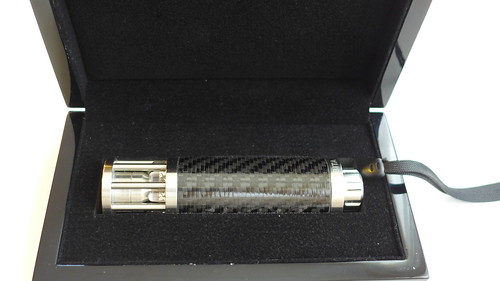
But, and this is a big deal, its not the most practically light in the world, even for a "luxury light." I don't think anyone would confuse my Mk. II Aeon for a cheapy Duracell light, but it is very practical. Here you get a tube of substantial size and girth with nothing to aid in carry or grip. That's one big hit. The ring of LEDs are hard to pin down. Sometimes I think they are nice and then I realize that a good ceiling bounce (aiming the light at the white ceiling which will disperse and bounce back a good portion of the light) does basically the same thing without the sickly tint of the secondary LEDs. That's a draw. So you get good marks for beauty and packaging (not that packaging matters much), bad marks for its form factor, and a draw on the secondary LEDs. That's a 1.
The performance numbers aren't good, in part because this light has a middle of road high for an 18650 light and because this thing is built like a traffic barrier. Here is the light next to the size reference Zippo.
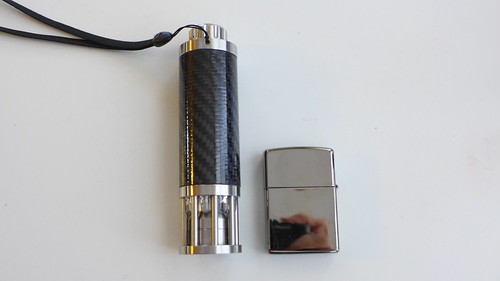
The total lumens output is found on...well...no where. The high is listed at 350 lumens, but there is no listed runtime for the high or any other mode. In short, we are guessing here. Runtime is a pretty crucial stat and to not include it at all is a sign of serious problems, either with the item itself or with marketing. The lumens:weight is 42, nothing like even big lights I have reviewed (the MMX-R is 163). The total weight of the light is listed at 7 ounces, but with the battery my model hits 8.32 ounces.
Fit and Finish: 2
Whether it is made in the US or in China, the Lighthouse is really quite marvelous in its fit and finish, especially the body tube sleeve and the holster. Here is a shot of the immaculately stitched leather holster:
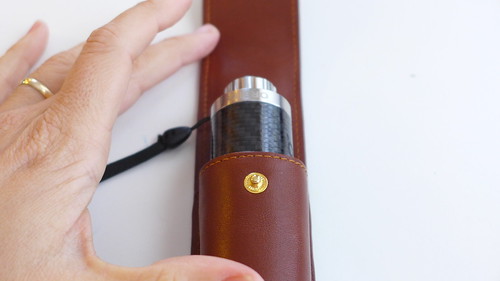
After pawing the light for over two months the only ding I could find is one of the secondary LEDs is slightly misaligned or crooked. The emitter was centered, the clicky was crisp, the threads were clean, smooth, and even.
Grip: 2
For all of its chubby dimensions, the Lighthouse is actually very nice in the hand. The carbon fiber is a little slick, but nothing offensive at all. I quite liked it.

The dimensions and ratios were very good. One thing that you should be aware of is the texture of the carbon fiber. Its somewhere between the slick feel of the Caly 3 and the basket weave of the Sage 1. It is very high gloss, but has a bit of grip or "scale" to it, kind of like fish scales. A normal ice pick grip is about all your are going to get out of this thing because the very large diameter makes a cigar grip impossible unless you have the hands of an NBA center.
Carry: 0
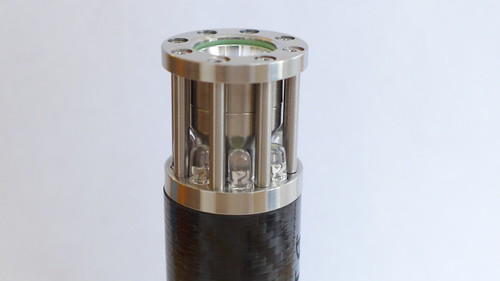
Lots of the new Fenix offerings for 2014 have primary and secondary LEDs to allow for both a flood and a throw beam and many customs do as well (the Lunasol 20, the Lunasol 27, and the Spy Tri-V). This unqiue feature is something worth exploring if you are a light manufacturer. Given how few lights actually have this set up, its hard for me to compare and contrast the systems to tell you which is better, but again options = better score.
Beam Quality: 1
The main beam is quite nice with very few artifacts and a pleasant enough tint.
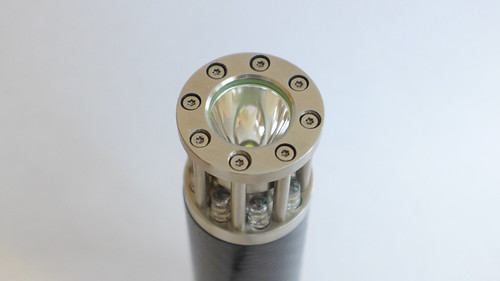
The ding here comes from the secondary LEDs which are not just bad, but quite awful. First, there placement makes for weird and disorienting shadows when the light is used as a candle. Second, the tint of these cheap bin LEDs is horrendous. The tint is somewhere between sallow and gangrenous. Its just awful.
UI: 0
This light has 6 output modes, but no medium. How did that happen? Additionally the disorienting modes are not hidden so you have to cycle through them to go from low to high. There is no mode memory either so you can't set up the UI for the next time you turn the light on. Finally, it uses an plain old clicky. The clicky alone is probably worth a 1, but the combination of a clicky, no medium, and no hidden strobe modes means the UI on the Lighthouse scores a 0.
Hands Free: 1
There is absolutely nothing to prevent this light from rolling away. I guess they assume that since it is a "luxury" light they don't need to worry about how it will handle work tasks. But then they include the tailstanding dish:
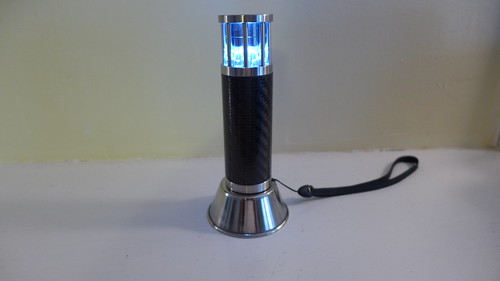
The dish works well, but it is kind of a design crutch. No one will carry it around with them, its just too awkward. The light should be able to tailstand on its own, but I guess this is an okay fix. This is BARELY a 1. I debated whether or not to give it a 0, but since it can, in theory, tailstand without the dish, I decided to keep it as a 1.
Overall Score: 10 of 20
For all of the controversy about the Lighthouse's origins, the light itself is pretty bad. Its bulky, not terribly bright given the battery, not terribly user friendly, and its expensive. It is nice looking. It does feel well made. But its just not a light I can recommend, either for EDC use or other purposes. The notion that a luxury item do not need to concern itself with practicality is absurd, unless its a piece of artwork. In my mind there should never be a piece of gear that is purely a Veblen good. Even the nicest Ron Lake folder can still cut things. But here, there is almost zero eye towards use.
The packaging is superb. No question about that and while I'd never up a score for packaging alone, it is impressive. Additionally the accessories are nice. The two 18650 batteries are good reputable batteries (from Ultrafire, the company that made the GatLight knock off some believe the Lighthouse to be, another piece of incriminating evidence). The charger is nice. Even the holster is amazing. The dish is pretty dumb, but everything else is decent. None of this, however, adds up to a light worth the staggering retail price (truly staggering if this is just an upscale version of the Ultrafire, as that sold for under $30 on Deal Extreme at one point).
I'd love to see Orbita take some of its machining know how and make its own light. There are plenty of good light designers out there they could collaborate with--a Prometheus Orbita collab would be killer. But the Lighthouse is just not a good light, regardless of provenance.
The Competition
The Fenix PD22 is nowhere near as beautiful, but it is significantly more useful and not appreciably dimmer. If these were the only two lights in the world, I'd never choose the Lighthouse. Compared to other 18650 lights, like the Eagletac TX25C2 and the FourSevens MMX-R there is no question this light is inferior. It may be pretty, but that's it.
Orbita is a luxury goods maker that started in the watch business. The make a series of watchwinders, devices that help keep mechanical watches running even when they are not on a wearer's body where the movement of the body keeps the watch wound. These watchwinders vary in size and cost, from a single watch unit that costs very little money to a closet sized design that keeps dozens of watches running that costs $50,000. Their site shows off these designs and includes impressive pictures and videos of their amazing craftsmanship. In particular, as a woodworker, I am jealous of how nice the lacquer finishes are on these beautiful boxes. Other pluses include the fact that Orbita is a US company and the stuff is all made here in the US.
A few years ago, seeing the potential for their luxury brand to expand, Orbita released a line of what they called "luxury flashlights". Now for the mainstream public that term probably sounds a bit odd, but for those of us that love flashlights, it was a phrase that made perfect sense. A McGizmo, for all of its flawless performance, is, in the final analysis, a luxury good. They released a few different designs each with different materials used in the flashlight's barrel. The Lighthouse was the model that seemed most interesting to me, so when I asked them for a review sample, that's what I asked for. I received an email from a real person and within days the package had arrived.
During the shipping period I started doing research on the light. There was a review, found here, on Layman's Guide to Flashlights (an excellent site, BTW) and he seemed to like it and the review had very little negative information in it. After reading that review I was pumped for the light. But I kept digging, as I always do when researching new products, and I found a few threads on the Orbita on CPF. There is no mistaking the fact that the Orbita Lighthouse bears a striking similarity to the Lumencraft GatLight. The materials are different--the GatLight was made of pure titanium while the Orbita is made of stainless steel and there are models that have a "sleeve" of other material around the main body of the light. Additionally, the GatLight had a rotating dial on the rear of the light that adjusted output, while the Orbita has a straightforward clicky. Finally, the GatLight had one central emitter, while the Orbita has both the central emitter, and a ring of LEDs that both give it its name and allow for wide dispersal of light when using the light in a tailstand.
The reason I kept researching was because I wanted to know about the origin of the Lighthouse's design. Was it an explicit continuation of the GatLight? Was it a licensed version? Was it just a happy coincidence that the two lights shared a look? Lumencraft stopped making lights a few years ago, so maybe, I thought, Orbita bought their design and/or remaining stock and did some mods. Oh no, its nothing like that. If you read this thread (starting at post #21) and this thread, you will quickly discover that Lumencraft and Orbita are at war with each other, or were at war with each other. You see, just like in the knife world where the pernicious Kevin Johns copies every successful blade design, there is a company out there willing to rip off any successful light design. Have you seen the Niteye Zip20 that looks like the Spy 007? Careful tracking by CPFers revealed that there was, in fact, a rip off version of the GatLight. Furthermore, the Lighthouse and this ripoff shared all of the traits that make the Lighthouse different from the GatLight--the lesser materials, the clicky, and the ring of LEDs. The similarities between the ripoff light, which cost around $30 and the Lighthouse (which cost around $250) were way too close. As you can see from the threads there was a back and forth between Lumencraft's representative and Orbita's representative.
As usual, I am simply going to give you the information and let you decide who is right. I contacted Orbita after I found this information and I sent them a link and asked for an explanation. They insisted that the Lighthouse is NOT that Chinese ripoff, that it is made entirely in the US, and that there are differences in the guts between the Chinese ripoff and the Lighthouse. Here is the exact email exchange:
I wrote:
Dear Orbita,
And I found this:
http://dx.com/p/xg-v3-cree-xp-g-4-mode-350-lumen-white-led-flashlight-with-8
x-f5-led-colorful-light-1-18650-55005?Utm_rid=72454787&Utm_sid=1&Utm_source=
affiliate&Utm_medium=dealextreme
What's the connection between this light and the Lighthouse? It seems to
have a lot of the same touches, even down to the GITD o-rings.
I just want to make sure I get everything correct for the review.
Tony
They replied:
Hi Anthony,
Here are the differences:
Our Model: XP-GQ5 LED
Our Modes: 6
Voltage: 3.7V 2600mAh
Lens: Sapphire Crystal
Runtime: 2-3 hours on HI
Lithium Battery: Included with ours
Our Flashlights are turned, finished and assembled in the USA. There are
always cheaply made Chinese knockoffs which look alike but are poor quality
and do not carry any warranty.
We offer Flashlight Sets which include (2) Rechargeable batteries, 110VAC
Charging Station and Leather Carrying Holster, Lantern Base and Black Gift
Box.
Let me know if you have any further questions.
I have no way of confirming or denying any of this. This is what Orbita told me and I have no reason to doubt it. It is possible they have an independently made light that just happens to look like the Chinese ripoff. That said, this is not the only Orbita light that looks like a Chinese ripoff. Here is the Orbita Slimline. Here is the Fandyfire XG-V5. Here is Dave's review of the Slimline on Layman's Guide. Bottom line: I just don't know. That's all of the information I could find and in the end it is just a bunch of people hurling accusations at a company on the internet. Whether those accusations are true is beyond my ability to determine, but you should at least know about them going into this review.
In summary, I cannot determine if the Lighthouse is:
1. An homage to the Gatlight made here in the USA.
2. A Chinese ripoff of the Gatlight with some "value added" touches.
3. An entirely USA made product.
I have asked the manufacturer and they have indicated that it is #3, but there is just too much out there to ignore. You now have all of that information, gathered in one spot and you can hopefully make your own decision. With that out of the way, I am going to evaluate the product separate and apart from this origins controversy. One last thing, there is nothing about the GatLight, so far as I am aware, that is patented or trademarked. Absent one of those things copies are perfectly legal, if somewhat distasteful. Additionally, the Ultrafire copies are NOT purporting to be the real thing like the Kevin Johns Hinderer which even go so far as to have Hinderer's name on the knife.
Here is the product page. The CF version costs $235 for the basic, light only package and $295 for the whole kit, which includes a nice lanyard, a good charger, a spare 18650 battery, and a reflector/tailstand dish. There are various options for body tube sleeves including wood, carbon fiber or plain stainless steel rods. Here is a written review. Here is a video overview. The light is only available from the Orbita site or specialty retailers. You can also purchase it from Amazon (sales benefit the site):
ORBITA Carbon Fiber Lighthouse Flashlight Set, includes Rechargeable Batteries and Italian Leather Case
Finally, here is my review sample (provided by Orbita and to be given away):

Review Summary: Big, bulky, and quirky with a heaping of controversy on the side.
Design: 1
The original GatLights were pretty, oh yes they were. The Lighthouse is similarly good looking, especially with the sleeve of material around the body tube. The presentation is simply unrivaled. The box it came in had a perfect piano finish. The accessories were also nicely done, especially the leather holster (see below). No question it is pretty, regardless of origin.

But, and this is a big deal, its not the most practically light in the world, even for a "luxury light." I don't think anyone would confuse my Mk. II Aeon for a cheapy Duracell light, but it is very practical. Here you get a tube of substantial size and girth with nothing to aid in carry or grip. That's one big hit. The ring of LEDs are hard to pin down. Sometimes I think they are nice and then I realize that a good ceiling bounce (aiming the light at the white ceiling which will disperse and bounce back a good portion of the light) does basically the same thing without the sickly tint of the secondary LEDs. That's a draw. So you get good marks for beauty and packaging (not that packaging matters much), bad marks for its form factor, and a draw on the secondary LEDs. That's a 1.
The performance numbers aren't good, in part because this light has a middle of road high for an 18650 light and because this thing is built like a traffic barrier. Here is the light next to the size reference Zippo.

The total lumens output is found on...well...no where. The high is listed at 350 lumens, but there is no listed runtime for the high or any other mode. In short, we are guessing here. Runtime is a pretty crucial stat and to not include it at all is a sign of serious problems, either with the item itself or with marketing. The lumens:weight is 42, nothing like even big lights I have reviewed (the MMX-R is 163). The total weight of the light is listed at 7 ounces, but with the battery my model hits 8.32 ounces.
Fit and Finish: 2
Whether it is made in the US or in China, the Lighthouse is really quite marvelous in its fit and finish, especially the body tube sleeve and the holster. Here is a shot of the immaculately stitched leather holster:

After pawing the light for over two months the only ding I could find is one of the secondary LEDs is slightly misaligned or crooked. The emitter was centered, the clicky was crisp, the threads were clean, smooth, and even.
Grip: 2
For all of its chubby dimensions, the Lighthouse is actually very nice in the hand. The carbon fiber is a little slick, but nothing offensive at all. I quite liked it.

The dimensions and ratios were very good. One thing that you should be aware of is the texture of the carbon fiber. Its somewhere between the slick feel of the Caly 3 and the basket weave of the Sage 1. It is very high gloss, but has a bit of grip or "scale" to it, kind of like fish scales. A normal ice pick grip is about all your are going to get out of this thing because the very large diameter makes a cigar grip impossible unless you have the hands of an NBA center.
Carry: 0
At over half a pound and with a portly size, this thing is not easy to carry in the pocket. The sheath, as gorgeously well made as it is, is also pretty cumbersome and very dorky (all sheathes are dorky, but this one, with its ostentatious presentation is a bit more so). The light also lacks a pocket clip, making it an overall poor light to lug around. If you want to try to simulate what its like to carry around take a piece of 1 1/4 inch diameter PVC, fill it with sand, seal the ends, and drop it in your pack or pocket. That's the Lighthouse. I guess this is inability to carry the light easily is one of those things, like a desk pen, that makes it "luxury", but that's sort of ridiculous, in light of stuff like the Haiku (or any McGizmo light).
Output: 1
Output: 1
We have no idea what the low is. We have no idea how long any mode lasts. The product literature claims that the output on high is 350 lumens, but we don't know if it is direct drive or regulated (its got to be regulated, right?). There are just too many unknowns for me to be definitive on anything other than this--350 lumens on high is below par for an 18650 light nowadays. The TX25C2 his 1100 lumens out the front, its medium is basically equal to the Lighthouse's high. The same goes for a comparison between the Zebralight SC600 Mk. II or the FourSevens MMX-R and the Lighthouse. Additionally, the Lighthouse has no medium, but a bunch of weird extra outputs. The "defensive" strobe is not hidden. Its right there after the low. Then there are the two modes that use the secondary LEDs--a candle mode that produces the sickest tint I have ever seen, and a beacon mode where the secondary LEDs light up one at a time in sequence. All of this is just bad.
Nonetheless I can't give a light that produces 350 lumens and has a low anything worse than a 1. Its a close call hear, given the other modes, the lack of hidden modes, and no data on anything other than the high, but all of that impacts our ability to assess the light compared to the competition, but it does not alter the fact that if you lost power, for example, the Lighthouse would still be pretty useful.
Runtime: 0
Runtime: 0
Without any data and no information about whether the light is regulated or not, I can't accurately assess runtimes. It may be great. It may be terrible, but not having this information out there is a huge problem. People use lights in emergencies, like when the power goes out, and not giving them information on runtime means they are less likely to use a light. They have a harder time depending on the light and in the end, that is why we EDC a light. If this data surfaces I am willing to revisit this portion of the review, but for now, it gets a zero.
Beam Type: 2
Beam Type: 2
You get both throw and flood here, even if neither is great. The ability to choose is a huge plus. I am not sure of the practicality of the secondary LEDs but simply by virtue of choice, this light gets a 2.

Lots of the new Fenix offerings for 2014 have primary and secondary LEDs to allow for both a flood and a throw beam and many customs do as well (the Lunasol 20, the Lunasol 27, and the Spy Tri-V). This unqiue feature is something worth exploring if you are a light manufacturer. Given how few lights actually have this set up, its hard for me to compare and contrast the systems to tell you which is better, but again options = better score.
Beam Quality: 1
The main beam is quite nice with very few artifacts and a pleasant enough tint.

The ding here comes from the secondary LEDs which are not just bad, but quite awful. First, there placement makes for weird and disorienting shadows when the light is used as a candle. Second, the tint of these cheap bin LEDs is horrendous. The tint is somewhere between sallow and gangrenous. Its just awful.
UI: 0
This light has 6 output modes, but no medium. How did that happen? Additionally the disorienting modes are not hidden so you have to cycle through them to go from low to high. There is no mode memory either so you can't set up the UI for the next time you turn the light on. Finally, it uses an plain old clicky. The clicky alone is probably worth a 1, but the combination of a clicky, no medium, and no hidden strobe modes means the UI on the Lighthouse scores a 0.
Hands Free: 1
There is absolutely nothing to prevent this light from rolling away. I guess they assume that since it is a "luxury" light they don't need to worry about how it will handle work tasks. But then they include the tailstanding dish:

The dish works well, but it is kind of a design crutch. No one will carry it around with them, its just too awkward. The light should be able to tailstand on its own, but I guess this is an okay fix. This is BARELY a 1. I debated whether or not to give it a 0, but since it can, in theory, tailstand without the dish, I decided to keep it as a 1.
Overall Score: 10 of 20
For all of the controversy about the Lighthouse's origins, the light itself is pretty bad. Its bulky, not terribly bright given the battery, not terribly user friendly, and its expensive. It is nice looking. It does feel well made. But its just not a light I can recommend, either for EDC use or other purposes. The notion that a luxury item do not need to concern itself with practicality is absurd, unless its a piece of artwork. In my mind there should never be a piece of gear that is purely a Veblen good. Even the nicest Ron Lake folder can still cut things. But here, there is almost zero eye towards use.
The packaging is superb. No question about that and while I'd never up a score for packaging alone, it is impressive. Additionally the accessories are nice. The two 18650 batteries are good reputable batteries (from Ultrafire, the company that made the GatLight knock off some believe the Lighthouse to be, another piece of incriminating evidence). The charger is nice. Even the holster is amazing. The dish is pretty dumb, but everything else is decent. None of this, however, adds up to a light worth the staggering retail price (truly staggering if this is just an upscale version of the Ultrafire, as that sold for under $30 on Deal Extreme at one point).
I'd love to see Orbita take some of its machining know how and make its own light. There are plenty of good light designers out there they could collaborate with--a Prometheus Orbita collab would be killer. But the Lighthouse is just not a good light, regardless of provenance.
The Competition
The Fenix PD22 is nowhere near as beautiful, but it is significantly more useful and not appreciably dimmer. If these were the only two lights in the world, I'd never choose the Lighthouse. Compared to other 18650 lights, like the Eagletac TX25C2 and the FourSevens MMX-R there is no question this light is inferior. It may be pretty, but that's it.
